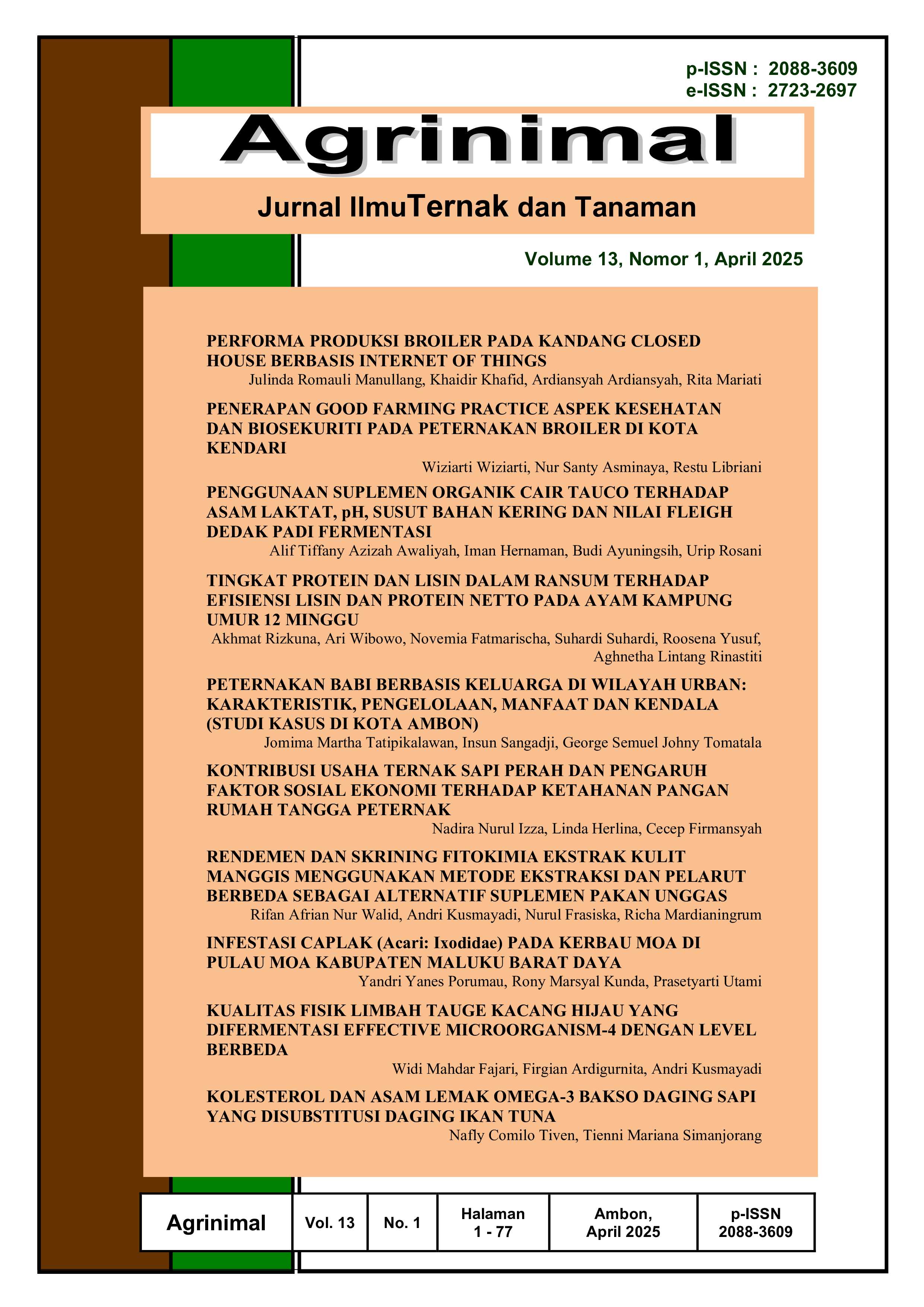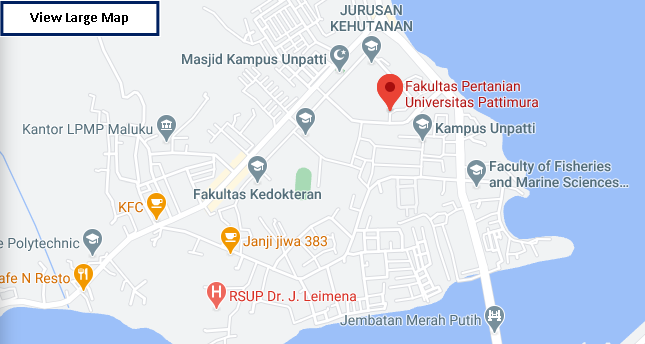INFESTASI CAPLAK (Acari: Ixodidae) PADA KERBAU MOA DI PULAU MOA KABUPATEN MALUKU BARAT DAYA
TICK INFESTATION (Acari: Ixodidae) IN MOA BUFFALO ON MOA ISLAND SOUTHWEST MALUKU REGENCY
Abstract
Penelitian ini bertujuan untuk mengidentifikasi jumlah, distribusi, dan preferensi infestasi caplak (famili Ixodidae) pada kerbau Moa di tiga desa di Kabupaten Maluku Barat Daya, yakni Klis, Tounwawan, dan Werwaru. Sebanyak 900 individu caplak berhasil dikoleksi dan didominasi oleh genus Haemaphysalis. Analisis infestasi berdasarkan lokasi menunjukkan bahwa Desa Klis memiliki jumlah kerbau terinfestasi tertinggi sebanyak 28 ekor, disusul oleh Desa Tounwawan dan Werwaru masing-masing dengan 15 ekor. Infestasi berdasarkan kelompok umur menunjukkan prevalensi yang signifikan lebih tinggi pada kerbau dewasa dibandingkan pedet (anak kerbau). Tidak ditemukan infestasi pada pedet di Desa Klis dan Tounwawan, sedangkan pada kelompok dewasa ditemukan masing-masing 325 dan 250 individu caplak dengan rata-rata infestasi per ekor sebesar 13 dan 12,5. Di Desa Werwaru, pedet menunjukkan infestasi ringan (rata-rata 0,38 caplak per ekor), sedangkan kelompok dewasa mengalami infestasi yang lebih berat dengan total 320 caplak (rata-rata 14,55 caplak per ekor). Berdasarkan bagian tubuh yang terinfestasi, telinga merupakan lokasi dominan dengan jumlah 369 caplak (41% dari total). Hal ini kemungkinan besar disebabkan oleh sifat telinga yang hangat, lembap, dan relatif terlindung, sehingga menjadi habitat ideal bagi caplak untuk berkembang biak. Hasil penelitian ini diharapkan dapat menjadi dasar dalam strategi pengendalian caplak yang efektif, dengan memperhatikan faktor umur, lokasi tubuh, dan distribusi spasial infestasi.
ABSTRACT
This study aimed to identify the number, distribution, and infestation preferences of ticks (family Ixodidae) on Moa buffalo in three villages in the Southwest Maluku Regency, i.e Klis, Tounwawan, and Werwaru. A total of 900 tick specimens were collected, predominantly from the genus Haemaphysalis. Infestation analysis based on location showed that Klis had the highest number of infested buffalo (28 individuals), followed by Tounwawan and Werwaru with 15 individuals each. Age-based infestation data revealed a significantly higher prevalence in adult buffalo compared to calves. No infestation was recorded in calves from Klis and Tounwawan, while adult buffalo in these villages were infested with 325 and 250 ticks, respectively, with an average of 13 and 12.5 ticks per animal. In Werwaru, calves showed mild infestation (average of 0.38 ticks per animal), while adult buffalo had more severe infestations with 320 ticks found (average of 14.55 per animal). Analysis of tick attachment sites on the buffalo's body revealed the ears as the most commonly infested area, with a total of 369 ticks (41% of the total count). This is likely due to the ears' warm, moist, and sheltered conditions, making them an ideal site for tick survival and reproduction. These findings are expected to serve as a basis for developing effective tick control strategies, considering factors such as age, body part preference, and spatial distribution of infestations.
Downloads
References
Abbasi, F., Abbasi, I.H.R., Nissa, T.F., Bhutto, Z.A., Arain, M.A., Soomro, R.N., Siyal, F.A., & Fazlani, S.A. (2017). Epidemiological study of tick infestation n buffalo of various regions of district Khairpur, Pakistan. Vet World, 10 (6): 688-694. https://doi.org/10.14202/vetworld.2017.688-694.
Abdallah, M.O., Niu, Q., Yang, J., Hassan, M.A., Yu, P., Guan, G., Chen, Z., Liu, G., Luo, J., & Yin, H. (2017). Identification of 12 piroplasms infecting ten tick species in China using reverse line blot hybridization. J Parasitol, 103 (3): 221-227. https://doi.org/10.1645/16-161.
Anderson, K., Ezenwa, V.O., & Jolles, A.E. (2013). Tick infestation patterns in free ranging African buffalo (Syncercus caffer): Effects of host innate immunity and niche segregation among tick species. Intl J Parasitol, 12: 1-9. https://doi.org/10.1016/j.ijppaw.2012.11.002.
Aiman, O., Ullah, S., Chitimia-Dobler, L., Nijhof, A.M., & Ali, A. (2022). First report of Nosomma monstrosum ticks infesting Asian water buffaloes (Bubalus bubalis) in Pakistan. Ticks Tick Borne Dis, 13 (2): 101899. https://doi.org/10.1016/j.ttbdis.2022.101899.
[BPS] Badan Pusat Statistik Kabupaten Maluku Barat Daya. (2022). Kecamatan Moa Lakor Dalam Angka. Tiakur: Badan Pusat Statistik Kabupaten Maluku Barat Daya.
[BPS] Badan Pusat Statistik Kabupaten Maluku Barat Daya. (2023). Kecamatan Moa Lakor Dalam Angka. Tiakur: Badan Pusat Statistik Kabupaten Maluku Barat Daya.
Barker, S.C., & Walker, A.R. (2014). Ticks of Australia. The species that infest domestic animals and humans. Zootaxa, 3816, 1-144. https://doi.org/10.11646/zootaxa.3816.1.1.
Batool, M., Nasir, S., Rafiq, A., Yousaf, I., & Yousaf, M. (2019). Prevalence of tick infestation in farm animals from Punjab, Pakistan. Pak Vet J, 39(3): 406-410. http://dx.doi.org/10.29261/pakvetj/2019.089.
Boulanger, N., Boyer, P., Talagrand-Reboul, E., & Hansmann, Y. (2019). Ticks and tick-borne diseases. Medecine et maladies infectieuses, 49 (2): 87-97. https://doi.org/10.101698./j.medmal.2019.01.007.
Bures, & Buton, L. (2012). Grourtperformance, carcas traits and meat quality of bulls and heifers slaughtered at different ages. Czech J Anim Sci, 57:34-43. https://doi.org/10.17221/5482-CJAS.
Etiang, P., Musoba, A., Nalumenya, D.P., Ndekezi, C., Bbira, J., Ochwo, S., Tweyongyere, R., & Muhanguzi, D. (2024). Distribution and prevalence of ixodid tick species (Acari: Ixodidae) infesting cattle in Karamoja region of northeastern Uganda. BMC Veterinary Research, 20: 1-13. https://doi.org/10.1186/s12917-023-03802-1.
Hamza, A., Mokhtaria, K., Ammar, S.S.M., & Taha, B. (2025). Identification, seasonal prevalence, and preferred attachment sites of ixodid tick species infesting cattle in four municipalities of the province of Tiaret, northwest Algeria. Exp Appl Acarol, 94(1):24. https://doi.org/10.1007/s10493-024-00994-5.
Iqbal, A., Usman, M.J., & Abubakar, M.B. (2017). Mini Review: Current tick control strategies in Pakistan are possible environmental risks. Iraqi journal of Veterinary Sciences, 31: 81-86. https://search.emarefa.net/detail/BIM-812181.
Jameson, L.J., Phipps, L.P., & Medlock, J.M. (2010). Surveillance for exotic ticks on companion animals in the UK. Veterinary Record, 166: 202 - 203. https://doi.org/10.1136/vr.b4786.
Kaur, D., J. Kamal, & M. Suman. (2015). Studies on prevalence of Ixodid tick infesting Cattle and their control by plant extracts. Iosr J.Pharm. Biol. Sci.10(6): 1-11. https://doi.org/10.9790/3008-10630111.
Nithikathkul, C., Polseela, P., Changsap, B., & Leemingsawat, S. (2002). Ixodid ticks on domestic animals in Samut Prakan Province, Thailand. Southeast Asian J Trop Med Public Health, 33 (S3): 41-44. https://pubmed.ncbi.nlm.nih.gov/12971472/.
Raghavan, R.K., Peterson, A.T., Cobos, M.E., Ganta, R.R., & Foley, D.H. (2019). Current and future distribution of the lone star tick, Amblyomma americanum (L.) (Acari: Ixodidae) in North America. PLoS ONE, 14 (1): e0209082. https://doi.org/10.1371/journal.pone.0209082.
Sahara, A., Budianto, B. H., Kunda, R. M., & Firdausy, L. W. (2023). Tick (Acari: Ixodidae) infestation in cattle from Sleman, Yogyakarta Province, Indonesia. Biodiversitas, 24(7): 4087-4094. https://doi.org/10.13057/biodiv/d240747.
Silaghi, C., Santos, A.S., Gomes, J., Christova, I., Matei, I.A., Walder, G., Domingos, A., Bell-Sakyi, L., Sprong, H., von Loewenich, F.D., Oteo, J.A., de la Fuente, J., & Dumler, J.S. (2017). Guidelines for the direct detection of Anaplasma spp. in diagnosis and epidemiological studies. Vector Borne Zoonotic Dis. 17(1):12-22. https://doi.org/10.1089/vbz.2016.1960.
Sonenshine, D.E., & Roe, R.M. (2014). Biology of Ticks. 2nd Edition. Oxford University Press.
Tatipikalawan, J.M., & Sangadji, I. (2024). Kearifan lokal dalam pengelolaan Kerbau Moa pada masyarakat Pulau Moa Provinsi Maluku. Jurnal Hutan Pulau-Pulau Kecil, 8(1), 11-21. https://doi.org/10.30598/jhppk.v8i1.12634.
Utami, P. (2021). Karakter morfologi dan molekuler ektoparasit caplak Ixodes cordifer pada Kuskus asal Maluku. Disertasi. Purwokerto: Fakultas Biologi Universitas Jenderal Soedirman.
Utami, P., Budianto, B.H., & Sahara, A. (2021). Tick acari Ixodidae infestation of Cuscus from Maluku Province, Indonesia. Veterinary Word,14(6)1465-1471. https://doi.org/10.14202/vetworld.2021.1465-1471.
Utami, P., & Kunda, R. M. (2023). Surface ultrastructure of tick (Acari: Ixodidae) on Moa buffalo from Southwest Maluku District, Indonesia. Biodiversitas 24(6): 3230-3235. https://doi.org/10.13057/biodiv/d240617.
Utami, P., Kunda, R.M., & Anaktototy, Y. (2024). First metagenome report of Haemaphysalis bispinosa ticks of Moa buffalo from Southwest Maluku District, Indonesia. Nusantara Bioscience, 16 (1): 130-138. https://doi.org/10.13057/nusbiosci/n160116.
Walker, A.R., Bouattour, A., Camicas, J.L., Estrada-Peña, A., Horak, I.G., Latif, A.A., Pegram, R.G., & Preston, P.M. (2003). Ticks of domestic animals in Africa: a guide to identification of species. Bioscience Reports, Edinburgh Scotland,U.K.








